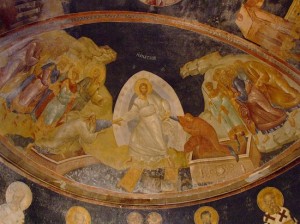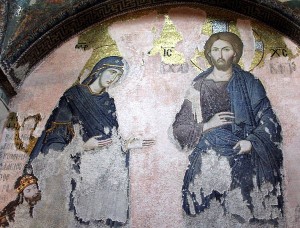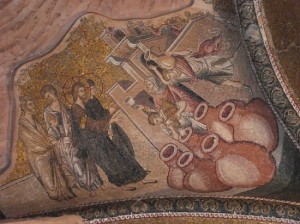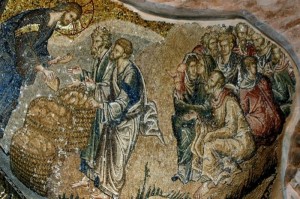Reflections on a Pauline Pilgrimage to Turkey [13]
“Now faith is the assurance of things hoped for, the conviction of things not seen.” [Hebrew 11:1]
[1] Christ as part of the Deesis mosaic. Photo © Dick Osseman. [2] Anastasis, photo © Jerzy Kociatkiewicz. [3] Deesis: Christ and the Virgin Mary (without John the Baptist)
The Church of St. Savior in Chora, Istanbul is a feast of mosaics and frescoes!
We were delighted to have a whole day in Istanbul on the final day of our trip. Remembering the glorious days of Constantinople in the history of the Church, we knew that there would be much to see in Istanbul. That amount of time accorded us with the golden opportunity to take in three important sites, the Blue Mosque, which is the pride of Turkish architecture, The Church of St Saviour in Chora, and the Hagia Sophia – two splendid Byzantine churches with immense treasures of breathtaking Christian art.
We began early in the morning with Chora, a church with a long history. In the Greek language, the word “Chora” means a suburban area or countryside. The Church of St. Savior was named Chora because it lied outside the city walls built by emperor Constantine. It was built by Justinian in AD 500’s on the site of a smaller church located outside of the City walls which had since been flattened by an earthquake. Rebuilt twice in the 9th and 11th centuries, Chora was partially destroyed in 1204 by the looting and destruction of Constantinople during the Fourth Crusade. It was rebuilt to roughly its present form around 1300, the main donor being Theodore Metochites, who is pictured in mosaic in the traditional pose of presenting a model of the church to Christ.
Today, the Chora is known as the Kariye Museum. It houses one of the best-preserved and the richest collections of Byzantine mosaics and frescoes in existence anywhere. Plastered and whitewashed over when the church was converted into a mosque in the 16th century, they have been painstakingly restored over the last fifty years with the active support of the American Byzantine Institute. These frescoes were painted in the first half of the thirteen hundreds, the same time as Giotto, the Lorenzetti brothers and Martini were at work in Siena and Florence. Their catechetical significance is huge.
In all there are some 50 mosaic panels dating from 1310, most of which are still in excellent conditions. Roughly following the chronological order, almost all the subjects of the mosaics derive from the New Testament. Most captivating of all for us were those mosaics depicting scenes from the life of the Virgin and Christ.
In the Anastasis [Greek for resurrection], we see a fresco of vivid presentation that assumed great importance throughout the entire Middle Ages. In what is also described as the “harrowing of hell”, Christ is shown taking Adam and Eve by the hands and leading them out of Hades. Behind Adam are John the Baptist, King David, King Solomon and other righteous kings, while behind Eve stand a whole host of the redeemed. Not only is this mosaic stunningly beautiful, its presentation is so vivid catechetically that even a long time after one has walked passed it, the image of Christ grabbing Adam and Eve in each of his hands and lifting them out of their tombs lingers on. Professing that part of the creed – “He descended to the dead” – is now artistically bolstered.
[1&2] Mosaic of Christ Pantocrator, south dome of inner narthex. [3] St Paul against a background of golden mosaic.
The Greek word deesis means entreaty, prayer, or supplication. In Byzantine art, the Deesis is a traditional iconic representation of Christ in Majesty or Christ Pantocrator: enthroned, carrying a book, and flanked by the Virgin Mary and St. John the Baptist who face towards Christ with their hands raised in supplication on behalf of humanity. It is usually a tripartite composition, but sometimes other saints and angels are included. This is a typical Last Judgment scene.
The Koimesis is a very interesting piece, in mosaic. Koimesis in Greek means “falling asleep in death”. The dormition [death] of the Virgin is first found in Byzantine art in the 900s and went on to become one of the most popular icons in the Middle and Late Byzantine world. An icon of Koimesis was often placed over the doors of churches to be contemplated by the faithful as they left the service. The Virgin is usually shown lying on a bier, or pallet, for the dead. With His golden garments, Christ is depicted in His divine glory in the middle of the icon, surrounded by angels, and holding a small child clothed in white representing the soul of the Virgin Mary. This baby is given to the attendant angels to take to heaven. The apostles stand witness, their posture directing attention towards the Theotokos. On the left, Saint Peter incenses the body of the Theotokos. On the right, Saint Paul bows low in honour of her. The Feast of the Dormition of Our Most Holy Lady, the Theotokos and Ever-Virgin Mary, is celebrated on August 15 each year. A holy day of obligation, the Feast of the Assumption of the Blessed Virgin Mary into Heaven at the end of her earthly life is a defined dogma of the Catholic Church.
The south dome of the inner narthex is spectacular. Christ Pantocrator sits on the apex of the dome glowing with golden brilliance. Rays of gold, as it were, radiate out from him, each ray featuring a pair of saints as it progresses towards the broadest circumference of the dome.
Out of the New Testament, many stories of miracles and healings were depicted. These are a few that caught our attention.
[1] Christ turning water into wine at the wedding in Cana. Photo © Dick Osseman.. [2] Christ performing the miracle of the loaves and fishes. Photo © Dick Osseman.. [3] Christ healing Peter’s mother-in-law. Photo © Dick Osseman.
On each side of the door leading from the inner narthex to the Naos , we find the mosaics pertaining to St. Peter and St. Paul. St. Paul, featured in an arched frame on the right, holds the Holy Bible in his left hand, while his right hand is slightly raised as he makes a sign of blessing.
Take your time and feast your eyes, as this treasure trove of Christian art leads you to contemplate the deeds of God in human history, for the salvation of humankind.
Copyright © Dr. Jeffrey & Angie Goh, February, 2012. All rights reserved.
You are most welcome to respond to this post. Email your comments to us at jeffangiegoh@gmail.com. You can also be dialogue partners in this Ephphatha Coffee-Corner Ministry by sending us questions for discussion.









